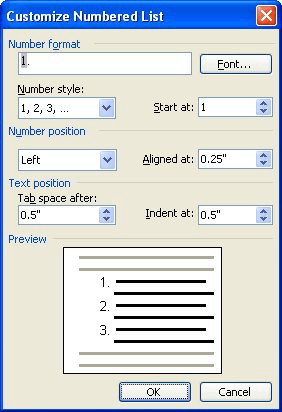Please Note: This article is written for users of the following Microsoft Word versions: 97, 2000, 2002, and 2003. If you are using a later version (Word 2007 or later), this tip may not work for you. For a version of this tip written specifically for later versions of Word, click here: Changing the Types of Numbers in a Numbered List.
Written by Allen Wyatt (last updated June 11, 2021)
This tip applies to Word 97, 2000, 2002, and 2003
When you are working with numbered lists, Word uses Arabic numerals, by default, to number the items. This number is followed by a period. You can change the numbering scheme Word uses to number your lists. Any of the following numbering types can be selected:
| Type | Selection | |
|---|---|---|
| Arabic | 1, 2, 3, 4 | |
| Uppercase Roman | I, II, III, IV | |
| Lowercase Roman | i, ii, iii, iv | |
| Uppercase Alphabetic | A, B, C, D | |
| Lowercase Alphabetic | a, b, c, d | |
| Ordinals | 1st, 2nd, 3rd, 4th | |
| Word Numbers | One, Two, Three, Four | |
| Word Ordinals | First, Second, Third, Fourth | |
| Leading Zeroes | 01, 02, 03, 04 |
You can also change the type of character that follows the numbered list number. It can be either a period (the default), a colon, or a right parenthesis. You can also specify that there should be no character following the number. To change the numbering type and the character following the number, follow these steps:

Figure 1. The Numbered tab of the Bullets and Numbering dialog box.

Figure 2. The Customize Numbered List dialog box.
WordTips is your source for cost-effective Microsoft Word training. (Microsoft Word is the most popular word processing software in the world.) This tip (1078) applies to Microsoft Word 97, 2000, 2002, and 2003. You can find a version of this tip for the ribbon interface of Word (Word 2007 and later) here: Changing the Types of Numbers in a Numbered List.

Discover the Power of Microsoft Office This beginner-friendly guide reveals the expert tips and strategies you need to skyrocket your productivity and use Office 365 like a pro. Mastering software like Word, Excel, and PowerPoint is essential to be more efficient and advance your career. Simple lessons guide you through every step, providing the knowledge you need to get started. Check out Microsoft Office 365 For Beginners today!
Do you want the numbers in your numbered lists to be aligned differently than they normally are? You can adjust the ...
Discover MoreIf you have a bunch of subdocuments, and each of those subdocuments contains numbered lists, you may find that you have ...
Discover MoreIf you know the secret, you can use actual words as "bullets" in a bulleted list. The built-in bulleted lists in Word ...
Discover MoreFREE SERVICE: Get tips like this every week in WordTips, a free productivity newsletter. Enter your address and click "Subscribe."
There are currently no comments for this tip. (Be the first to leave your comment—just use the simple form above!)
Got a version of Word that uses the menu interface (Word 97, Word 2000, Word 2002, or Word 2003)? This site is for you! If you use a later version of Word, visit our WordTips site focusing on the ribbon interface.
Visit the WordTips channel on YouTube
FREE SERVICE: Get tips like this every week in WordTips, a free productivity newsletter. Enter your address and click "Subscribe."
Copyright © 2025 Sharon Parq Associates, Inc.
Comments